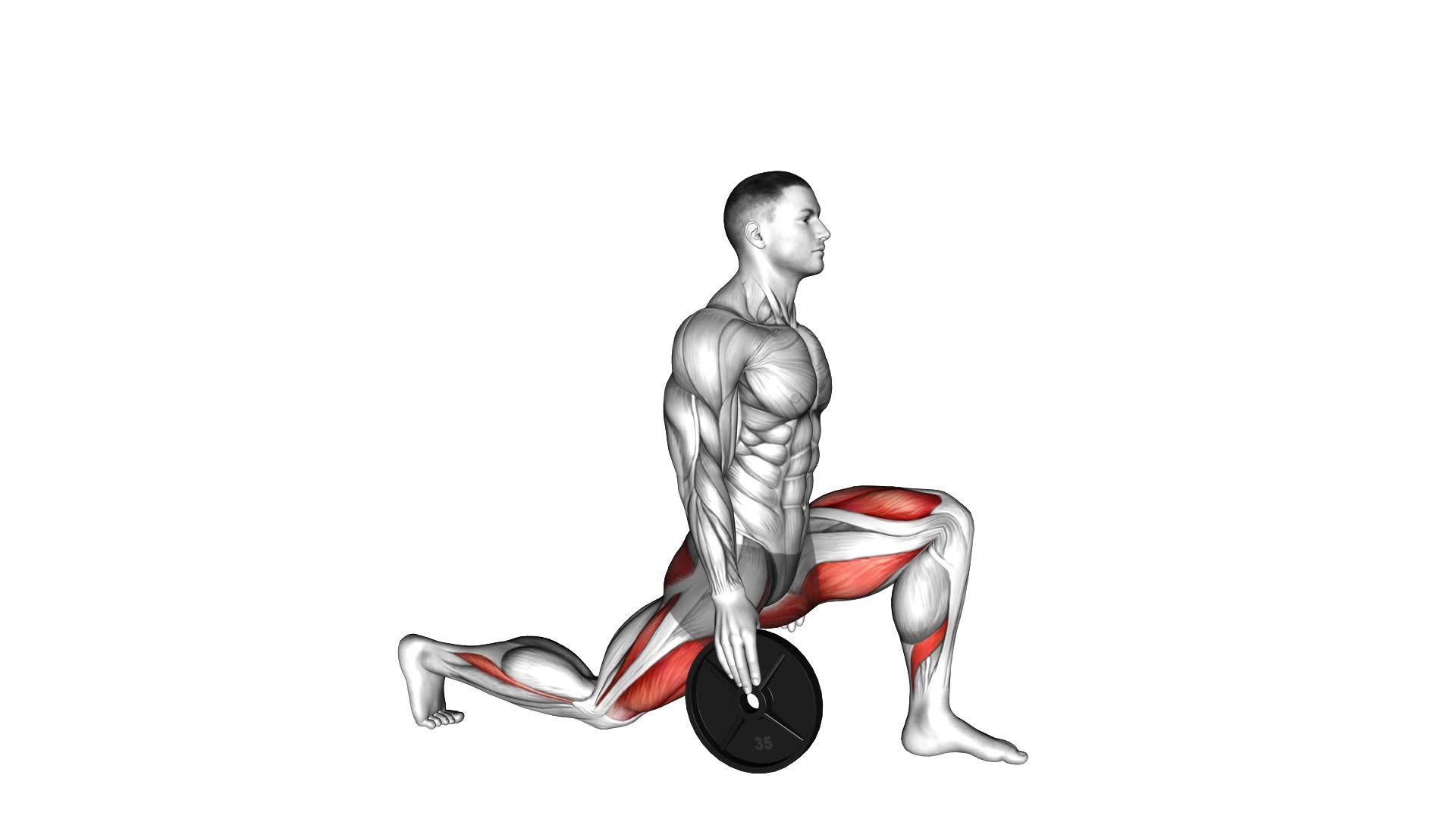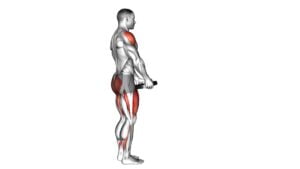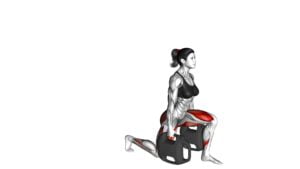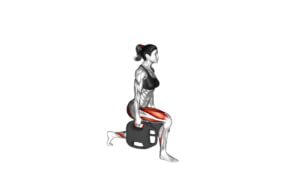Weighted Stretch Lunge – Video Exercise Guide & Tips

Are you looking for a challenging exercise that targets multiple muscle groups? Look no further than the weighted stretch lunge!
Watch This Exercise Video
This exercise helps improve flexibility, strength, and balance all at once. In this article, we'll guide you through proper technique, tips for choosing the right weight, and common mistakes to avoid.
With our video exercise guide and helpful tips, you'll be able to master the weighted stretch lunge and take your fitness to the next level.
Key Takeaways
- The Weighted Stretch Lunge improves flexibility, strength, and balance.
- It engages multiple muscle groups in the lower body and increases lower body strength and stability.
- The exercise enhances overall flexibility and aids in weight loss by burning calories.
- It is important to choose the right weight for the exercise based on strength and fitness level, gradually increasing the weight as strength improves.
Benefits of the Weighted Stretch Lunge
You will experience increased flexibility and strength in your lower body when performing the weighted stretch lunge. This exercise combines the benefits of stretching techniques with the added challenge of weight resistance. By incorporating weights into your lunge, you engage and activate more muscles in your legs, including your quads, hamstrings, glutes, and calves. This leads to improved lower body strength and stability. The added weight also increases the intensity of the stretch, helping to improve your overall flexibility.
There are variations and modifications you can incorporate into the weighted stretch lunge to target different muscle groups and add variety to your workout routine. One variation is the overhead weighted stretch lunge, where you hold a weight overhead while performing the lunge. This not only challenges your lower body but also engages your core and upper body muscles.
Another modification is the reverse weighted stretch lunge, where you step back into the lunge instead of forward. This variation places more emphasis on your glutes and hamstrings.
Incorporating the weighted stretch lunge into your fitness routine can help you achieve increased flexibility and strength in your lower body. By experimenting with different variations and modifications, you can continue to challenge your muscles and avoid plateaus in your progress.
Proper Technique for the Weighted Stretch Lunge
To perform the weighted stretch lunge correctly, ensure that you have a weighted object, such as dumbbells or a barbell, and follow these steps.
Start by standing tall with your feet hip-width apart and holding the weighted object in both hands, resting it on your shoulders.
Take a step forward with your right foot, keeping your core engaged and your back straight. Lower your body by bending both knees until your right thigh is parallel to the ground, and your left knee is hovering just above the floor.
Make sure your right knee is directly above your ankle and your left knee is in line with your hip. Push through your right heel to return to the starting position and repeat on the other side.
Now, let's address some common mistakes when performing the weighted stretch lunge.
One mistake is allowing your front knee to extend beyond your toes, which can put excessive stress on your knee joint. Another common mistake is leaning too far forward, which can strain your lower back.
To avoid these mistakes, focus on maintaining proper form and control throughout the movement.
To increase the intensity of the weighted stretch lunge, you can try increasing the weight of the object you're holding or adding more repetitions. You can also try incorporating variations such as walking lunges or reverse lunges.
Remember to always listen to your body and progress gradually to prevent injury.
Now that you know the proper technique and how to increase the intensity, let's move on to the next section: how to choose the right weight for the exercise.
How to Choose the Right Weight for the Exercise
When selecting the appropriate weight for the exercise, consider your strength and fitness level. Choosing weights that are too heavy can lead to improper form and potential injury, while choosing weights that are too light may not provide enough resistance to challenge your muscles effectively.
Here are some weight selection tips to help you choose the right weight for the Weighted Stretch Lunge:
- Start with a weight that allows you to perform the exercise with proper form. This means maintaining a straight back, keeping your core engaged, and ensuring that your front knee stays aligned with your ankle.
- Gradually increase the weight as you become stronger and more comfortable with the exercise. This will help you continue to challenge your muscles and make progress over time.
- Listen to your body and adjust the weight as needed. If you find that you're struggling to complete the exercise with good form, it may be time to decrease the weight. On the other hand, if the exercise feels too easy, consider increasing the weight to continue challenging yourself.
Common Mistakes to Avoid During the Weighted Stretch Lunge
To ensure proper form and maximize the effectiveness of the Weighted Stretch Lunge, it's crucial to avoid common mistakes. By following these form tips, you can perform the exercise correctly and minimize the risk of injury.
One common mistake isn't maintaining proper alignment. Make sure your front knee stays directly above your ankle and doesn't extend past your toes. This will help protect your knee joint and engage the correct muscles.
Another mistake is leaning too far forward. Keep your torso upright and avoid leaning forward excessively. This will help target your glutes and hamstrings more effectively.
Not engaging your core is another common mistake. Your core muscles play a crucial role in stabilizing your body during the exercise. Keep your abs engaged and your spine neutral to improve balance and stability.
Lastly, avoid rushing through the exercise. Take your time and focus on performing each rep with control and precision. This will ensure that you're targeting the right muscles and maximizing the benefits of the exercise.
Tips for Increasing Intensity and Progression in the Exercise
To increase the intensity and progression in the Weighted Stretch Lunge, you can incorporate additional weight or resistance.
Here are some tips to help you increase the difficulty and try advanced variations of the exercise:
- Use dumbbells or a barbell: Hold a pair of dumbbells or a barbell on your shoulders while performing the weighted stretch lunge. This will add resistance and make the exercise more challenging for your lower body muscles.
- Increase the weight gradually: Start with a lighter weight and gradually increase the weight as you get stronger and more comfortable with the exercise. This will help you continue to challenge your muscles and make progress over time.
- Try different variations: Once you have mastered the basic weighted stretch lunge, you can try different variations to further increase the intensity. Some advanced variations include the walking lunge, reverse lunge, or plyometric lunge. These variations engage different muscles and add an extra challenge to your workout.
By incorporating additional weight or resistance, gradually increasing the weight, and trying different variations, you can effectively increase the intensity and progression in the Weighted Stretch Lunge.
Remember to always listen to your body and work within your limits to avoid injury.
Frequently Asked Questions
Can the Weighted Stretch Lunge Help With Improving Flexibility?
Yes, the weighted stretch lunge can help improve flexibility. By incorporating weights into the lunge exercise, you're adding resistance which forces your muscles to stretch further. This increased stretch helps to improve flexibility over time.
Additionally, the weighted stretch lunge also helps in improving balance and increasing lower body strength. It's an effective exercise that targets multiple muscle groups and can be beneficial for overall fitness and flexibility goals.
Is It Necessary to Use Weights While Performing the Stretch Lunge?
Using weights while performing the stretch lunge can provide additional benefits. It helps to increase the intensity of the exercise, leading to greater muscle strength and endurance. By adding resistance, you challenge your muscles even more, promoting further development.
However, it isn't necessary to use weights while doing the stretch lunge. You can still reap the benefits by focusing on proper form and engaging your muscles effectively.
How Often Should I Include the Weighted Stretch Lunge in My Workout Routine?
To progress in weighted stretch lunges, it's important to include them in your workout routine regularly. By adding weights, you can increase the intensity and challenge your muscles even more.
The benefits of incorporating weighted stretch lunges in your routine include improved lower body strength and flexibility. Aim to do them at least 2-3 times a week, gradually increasing the weight and number of sets as you get stronger.
Remember to use proper form and listen to your body to avoid injury.
Can the Weighted Stretch Lunge Help With Targeting Specific Muscle Groups?
The weighted stretch lunge is a beneficial exercise for targeting specific muscle groups. By incorporating this exercise into your routine, you can improve muscle strength and increase balance and stability.
It allows you to work your quadriceps, hamstrings, glutes, and core all at once. The added weight provides an extra challenge, making your muscles work harder.
Incorporating the weighted stretch lunge into your workout routine can help you achieve your fitness goals more effectively.
Are There Any Modifications or Variations of the Weighted Stretch Lunge for Beginners?
There are modifications and variations of the weighted stretch lunge that are suitable for beginners. These modifications can help you ease into the exercise and avoid any strain or injury.
By starting with bodyweight lunges, you can build strength and stability before adding weights. Additionally, you can try using a support like a chair or wall for balance.
As you progress, you can gradually increase the weight or try different lunge variations to challenge yourself.
Conclusion
The weighted stretch lunge is a beneficial exercise that can help improve lower body strength and flexibility. By following the proper technique and choosing the right weight, you can maximize the results of this exercise.
It's important to avoid common mistakes and gradually increase intensity for progression. Incorporating the weighted stretch lunge into your workout routine can lead to positive fitness outcomes.

Author
Years ago, the spark of my life’s passion ignited in my mind the moment I stepped into the local gym for the first time. The inaugural bead of perspiration, the initial endeavor, the very first surge of endorphins, and a sense of pride that washed over me post-workout marked the beginning of my deep-seated interest in strength sports, fitness, and sports nutrition. This very curiosity blossomed rapidly into a profound fascination, propelling me to earn a Master’s degree in Physical Education from the Academy of Physical Education in Krakow, followed by a Sports Manager diploma from the Jagiellonian University. My journey of growth led me to gain more specialized qualifications, such as being a certified personal trainer with a focus on sports dietetics, a lifeguard, and an instructor for wellness and corrective gymnastics. Theoretical knowledge paired seamlessly with practical experience, reinforcing my belief that the transformation of individuals under my guidance was also a reflection of my personal growth. This belief holds true even today. Each day, I strive to push the boundaries and explore new realms. These realms gently elevate me to greater heights. The unique combination of passion for my field and the continuous quest for growth fuels my drive to break new ground.







